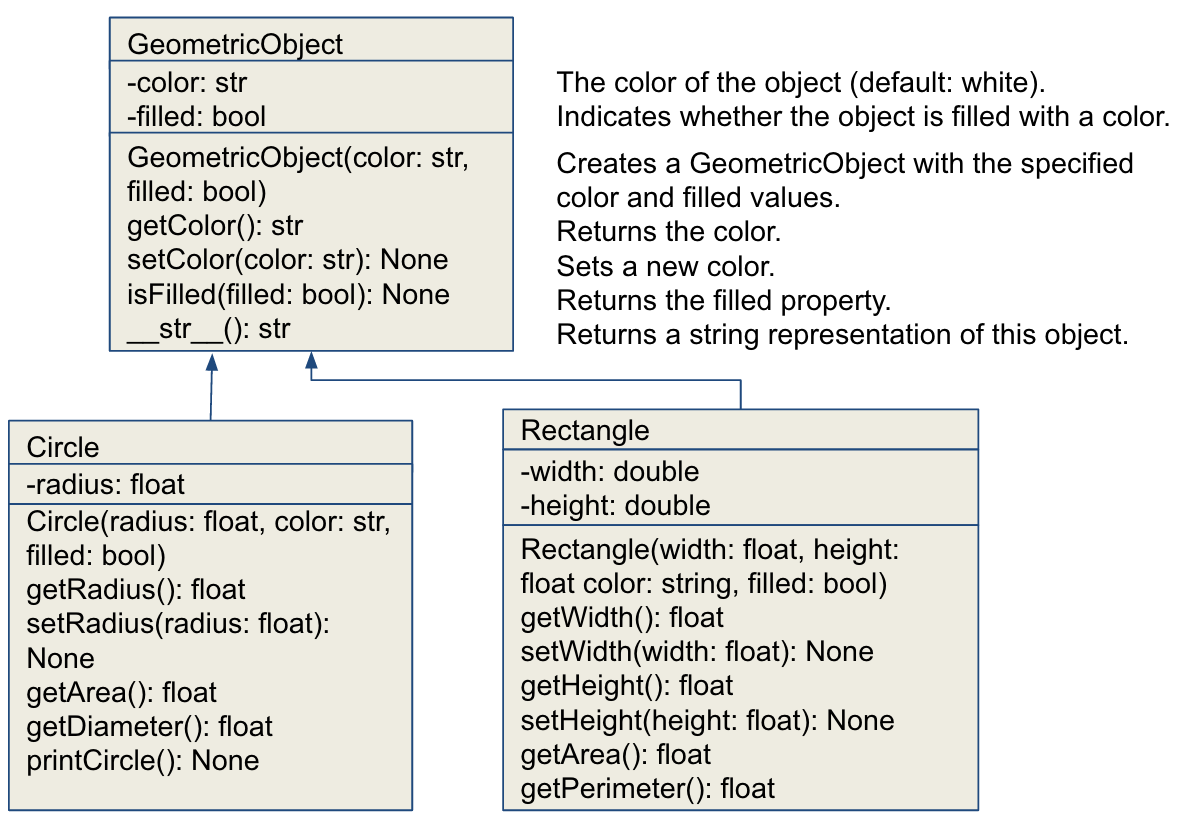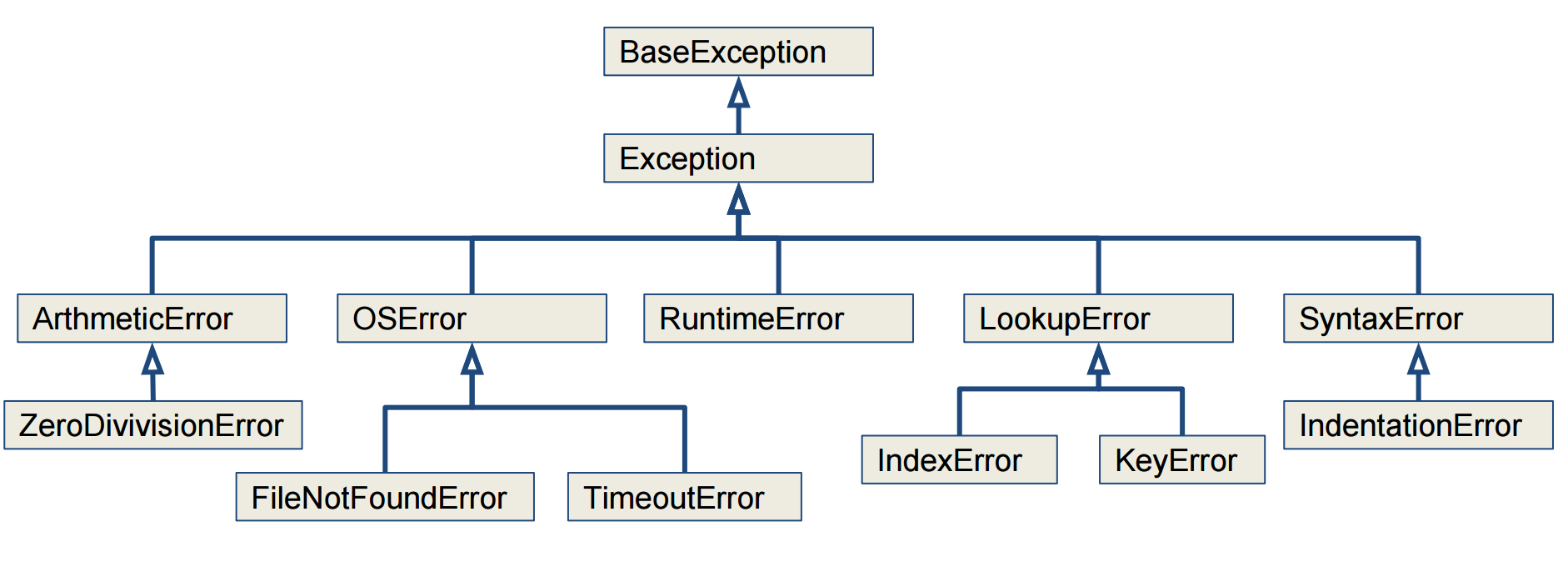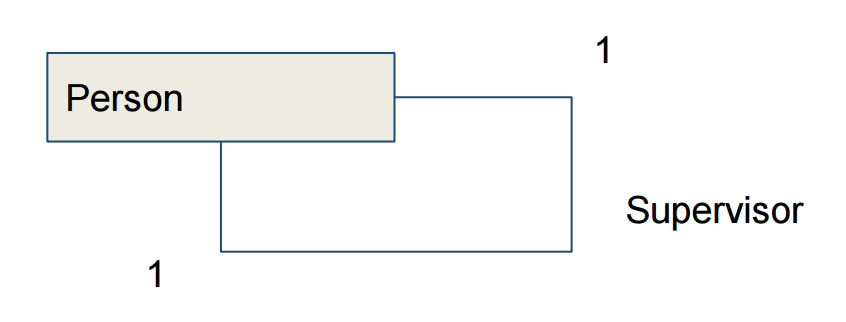Introduction to programming using Python
Session 8
Matthieu Choplin
Objectives
- To develop a subclass from a superclass through inheritance
- To override methods in the subclass
- To understand encapsulation in Python
- To explore the object class and its methods
- To understand polymorphism and dynamic binding
- To determine if an object is an instance of a class using the isinstance function
- To discover relationships among classes
- To design classes using composition and inheritance relationships
Definition
- Inheritance enables you to define a general class (a superclass) and later extend it to more specialized classes (subclasses).
- Example: a class Rectangle and a class Circle. They share common attributes and methods such as the attribute color.
- Common attributes and methods can be put in a parent class.
- Using inheritance enables to avoid redundancy
UML representation of inheritance

Superclasses and Subclasses
- The syntax of inheritance is:
- If you want to call the method of the superclass, use super()
- In particular, call super().__init__() to get the superclass attributes accessible from the subclass
class Child(Parent):
# class bodyAs an example, see the following programs:
Try to fix the program
class A:
def __init__(self, i = 0):
self.i = i
class B(A):
def __init__(self, j = 0):
self.j = j
def main():
b = B()
print(b.i)
print(b.j)
main()Solution
Hide solution
Do not forget to call the __init__() method of the superclass
Exercise: create a Rectangle Class inheriting from GeometricObject
- We already have the class diagram
- We want to be able to run this script: TestCircleRectangle.py
- Create the file
RectangleDerivedFromGeometricObject.py in which you will create the class Rectangle inheriting from GeometricObject
Overriding Methods
A subclass inherits methods from a superclass. Sometimes it is necessary for the subclass to modify the implementation of a method defined in the superclass. This is referred to as method overriding.
__str__ is a special method used to represent the object
class Circle(GeometricObject):
# Override the __str__ method defined in GeometricObject
def __str__(self):
return super().__str__() + " radius: " + \
str(self.__radius)Exercise: override the __str__ method
For the class rectangle, override the class __str__ so that when I print a rectangle object it says "Rectangle of area 4 and perimeter 8"
Solution using "+" concatenation
Hide solution
def __str__(self):
return "Rectangle of area " + str(self.getArea()) +\
" and of perimeter " + str(self.getPerimeter())Solution using format()
Hide solution
def __str__(self):
return "Rectangle of area {:.2f} and of perimeter {:.2f}".format(
self.getArea(), self.getPerimeter())Learn more about string formatting
Many ways to format strings in python, see this website: https://pyformat.info/
The object Class
- Every class in Python is descended from the object class. If no inheritance is specified when a class is defined, the superclass of the class is object by default.
- There are more than a dozen methods defined in the object class. We discuss four methods __new__(), __init__(), __str__(), and __eq__(other) here.

The __new__, __init__ Methods
- All methods defined in the object class are special methods with two leading underscores and two trailing underscores.
- The __new__() method is automatically invoked when an object is constructed. This method then invokes the __init__() method to initialize the object. Normally you should only override the __init__() method to initialize the data fields defined in the new class.
The __str__ Method
- The __str__() method returns a string representation for the object. By default, it returns a string consisting of a class name of which the object is an instance and the object’s memory address in hexadecimal.
def __str__(self):
return "color: " + self.__color + \
" and filled: " + str(self.__filled) The __eq__ Method
- The __eq__(other) method returns True if two objects are the same. By default, x.__eq__(y) (i.e., x == y) returns False, but x.__eq__(x) is True. You can override this method to return True if two objects have the same contents.
Override __eq__
Polymorphism
- The inheritance relationship enables a subclass to inherit features from its superclass with additional new features.
- A subclass is a specialization of its superclass; every instance of a subclass is also an instance of its superclass, but not vice versa. For example, every circle is a geometric object, but not every geometric object is a circle. Therefore, you can always pass an instance of a subclass to a parameter of its superclass type.
- Examples:
Exercise: Polymorphism
- Create 3 classes in a polymorphic way
- Complete the following script:
Dynamic Binding
Dynamic binding works as follows: Suppose an object o is an instance of classes C1, C2, ..., Cn-1, and Cn, where C1 is a subclass of C2, C2 is a subclass of C3, ..., and Cn-1 is a subclass of Cn. That is, Cn is the most general class, and C1 is the most specific class. In Python, Cn is the object class. If o invokes a method p, Python searches the implementation for the method p in C1, C2, ..., Cn-1 and Cn, in this order, until it is found. Once an implementation is found, the search stops and the first-found implementation is invoked.

Dynamic Binding: example
The isinstance Function
- The isinstance function can be used to determine if an object is an instance of a class.
- See the example program IsinstanceDemo.py
isinstance() compared to type()
- isinstance take into account inheritance, an instance of a derived class is an instance of a base class too
- NB: the instance are created on the fly here, we do not pass them to a variable
The hierarchy of the type of Exceptions
You can find the full hierarchy on https://docs.python.org/3/library/exceptions.html#exception-hierarchy

Defining Custom Exception Classes
See how we inherit from RunTimeError in the class InvalidRadiusException in the example CircleWithCustomException.py and how we use it in TestCircleWithCustomException.py
Encapsulation
- The syntax we have seen so far for data encapsulation is to use 2 underscore in front of the attribute we want to hide, which forces us to use getter and setter to access and modify the field.
class C:
def __init__(self,x):
self.__x = x
def getX(self):
return self.__x
def setX(self, x):
self.__x = xEncapsulation and data mangling
- The use of double leading underscores causes the name to be mangled to something else. Specifically, the private attributes in the preceding class get renamed to _C__x. At this point, you might ask what purpose such name mangling serves. The answer is inheritance - such attributes cannot be overridden via inheritance. For example:
class C:
def __init__(self,x):
self.__x = x
class A(C):
def __init__(self):
super().__init__(2)
# Does not override C.__x
self.__x = 1
a = A()
print(a._A__x)
print(a._C__x)
Encapsulation in a more pythonic way
- We can use property to customize access to an attribute
class C:
def __init__(self,x):
self.setX(x)
def getX(self):
return self.__x
def setX(self, x):
if x < 0:
self.__x = 0
elif x > 1000:
self.__x = 1000
else:
self.__x = x
x = property(getX, setX)Equivalent using decorators
class P:
def __init__(self,x):
self.x = x
@property
def x(self):
return self.__x
@x.setter
def x(self, x):
if x < 0:
self.__x = 0
elif x > 1000:
self.__x = 1000
else:
self.__x = xProperties should only be used in cases where you actually need to perform extra processing on attribute access
Relationships among Classes
- Association
- Aggregation
- Composition
- Inheritance
Association
- Association represents a general binary relationship that describes an activity between two classes.
- The association relations are implemented using data fields and methods in classes.

Aggregation and Composition
- Aggregation is a special form of association, which represents an ownership relationship between two classes. Aggregation models the has-a relationship. If an object is exclusively owned by an aggregated object, the relationship between the object and its aggregated object is referred to as composition.

Aggregation Between Same Class objects
- Aggregation may exist between objects of the same class. For example, a person may have a supervisor.

class Person:
def __init__(self,supervisor):
self.supervisor = supervisoris-a relationship vs has-a relationship
- Inheritance is for the is-a relationship
- Composition and aggregation is for the has-a relationship
Multiple inheritance
- Syntax for multiple inheritance:
- Note: as soon as we explicitly inherits from a class, we are in the case of multiple inheritance because in python all classes inherits from object by default
class Child(ParentA, ParentB):
# rest of the classExercises on Inheritance and OOP
- The Account class
- Game: ATM Machine
Exercise: The Account class (1)
Design a class named Account that contains:
- A private int data field named id for the account.
- A private float data field named balance for the account.
- A private float data field named annualInterestRate that stores the current interest rate.
- A constructor that creates an account with the specified id (default 0), initial balance (default 100), and annual interest rate (default 0).
- The accessor and mutator methods for id, balance, and annualInterestRate.
- A method named getMonthlyInterestRate() that returns the monthly interest rate.
- A method named getMonthlyInterest() that returns the monthly interest.
- A method named withdraw that withdraws a specified amount from the account.
- A method named deposit that deposits a specified amount to the account.
NB: for making fields private, use this, remember that you can also use properties
Exercise: The Account class (2)
Draw the UML diagram for the class, and then implement the class. (Hint: The method getMonthlyInterest() is to return the monthly interest amount, not the interest rate. Use this formula to calculate the monthly interest: balance * monthlyInterestRate.
monthlyInterestRate is annualInterestRate / 12. Note that annualInterestRate is a percent (like 4.5%). You need to divide it by 100.)
Write a test program that creates an Account object with an account id of 1122, a balance of £20,000, and an annual interest rate of 4.5%. Use the withdraw method to withdraw £2,500, use the deposit method to deposit £3,000, and print the id, balance, monthly interest rate, and monthly interest.
Exercise on Inheritance and OOP
Use the Account class created in the previous exercise to simulate an ATM machine. Create ten accounts in a list with the ids 0, 1, ..., 9, and an initial balance of £100. The system prompts the user to enter an id. If the id is entered incorrectly, ask the user to enter a correct id. Once an id is accepted, the main menu is displayed as shown in the sample run. You can enter a choice of 1 for viewing the current balance, 2 for withdrawing money, 3 for depositing money, and 4 for exiting the main menu. Once you exit, the system will prompt for an id again. So, once the system starts, it won't stop.
Solution OOP
Show solution
Hide solution
See the file oop_account.pyand oop_atm.py
You can write a better program 😁
